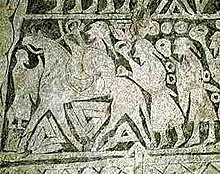Tängelgårda stones

The Lärbro Tängelgårda stones are a group of four Gotland stones in the Swedish History Museum Stockholm, of which three, numbers I, III, and IV are image stones. The best known of these, Tängelgårda I, includes scenes that have been interpreted in terms of the cult of Odin. The stones were found together at a site in Lärbro parish, and are believed to have been re-used to enclose a grave.
Provenance
[edit]The four stones were discovered in the 1860s at Fånggården, near the farm of Tängelgårda, in Lärbro parish on Gotland, and removed to the Swedish History Museum.[1][2] The site, presumed to have been a stone setting in which the four stones had been reused, was not investigated and the exact location has been lost.[3][4]
Tängelgårda I
[edit]
The largest and best known of the group, Tängelgårda I is a five-panel tall stone variously dated to 400–550 CE,[5] the 8th century,[6] or the Viking Age, between 800 and 1100.[7][8][9] The bottom panel shows a large ship. The upper four panels have been related to the cult of Odin; they include a battle scene with birds of prey (ravens) in the top panel,[9] a horse in the third panel with additional legs or other structures under it (possibly Odin's eight-legged horse, Sleipnir),[10] and two valknuts in the fourth panel. The procession of men with downward-pointed swords in the third panel appears funereal; there appears to be a body lying on the horse's back. In the fourth panel, the rider and the men following him raise rings in one hand that have been compared to oath rings[11] and to rings bestowed by Germanic lords on their followers.[6] This fourth panel has been interpreted as a hero and his followers being welcomed into Valhalla, and related specifically to the legend of Sigurd.[12]
Tängelgårda III
[edit]Tängelgårda III, a three-panel tall stone, is heavily damaged. It is dated to the Viking Age, between 800 and 1100.[13] The third panel depicts a ship; the first and second show two horses that may have been carved using the same template as the three horses on Tängelgårda I.[14]
Tängelgärda IV
[edit]
Tängelgårda IV is a two-panel dwarf stone with a suggested date range of the second half of the 8th century[15] or more broadly the Viking Age or earlier, between 500 and 1100,[16] or to the Viking Age or the early Middle Ages, between 800 and 1250.[17] It depicts men drinking from horns and standing in a building. All but one of the figures may have been carved using the same template.[14] Tängelgårda II, a "blind" (blank) stone, is of similar shape to Tängelgårda IV.
See also
[edit]- Stora Hammars stones, another group of four stones from Lärbro
References
[edit]- ^ Catalog entry, acquisition number 4373, Swedish History Museum (pdf) (in Swedish): reporting removal of the stones in 1870.
- ^ Site inventory, 1976 (in Swedish): an informer who was then a child reported that the stones were removed in the first decade of the 20th century.
- ^ L1976:8357, Lärbro 353:1, original site of SHM 4373, Swedish National Heritage Board Fornsök database, retrieved 24 March 2024 (in Swedish).
- ^ Birgitta Gustafsson, "Bortförda från Tängelgårda - minnessten på plats efter 100 år", Populär Arkeologi 3-2004 (in Swedish). Archived from the original on 25 May 2012.
- ^ Inventory number 108186, Swedish Historical Museum Kringla database, retrieved 24 March 2024 (in Swedish).
- ^ a b "Bildsten från Tängelgårda", Swedish Historical Museum (in Swedish). Archived from the original on 12 January 2014.
- ^ Tängelgårdastenarna: 108186, Exhibition page, Swedish Historical Museum (in Swedish).
- ^ Laila Kitzler Åhlfeldt, "Picture-stone workshops on Viking Age Gotland—a study of craftworkers' traces", in: Wilhelm Heizmann and Sigmund Oehrl, eds., Bilddenkmäler zur germanischen Götter- und Heldensage, Berlin: De Gruyter, 2015, ISBN 9783110417685, pp. 397–462, p. 399.
- ^ a b Judith Jesch, The Scandinavians from the Vendel Period to the Tenth Century: An Ethnographic Perspective, Woodbridge, Suffolk: Boydell, 2002, ISBN 978-0-85115-867-9, p. 252.
- ^ Åhlfeldt, pp. 416–17.
- ^ Martina Stein-Wilkeshuis, "Scandinavians swearing oaths in tenth-century Russia: Pagans and Christians", Journal of Medieval History 28 (2002) 155–68, pp. 163–64.
- ^ Anders Andrén, "Dörrar till förgångna myter. En tolkning av de gotländska bildstenarna", in: Anders Andrén, ed., Medeltidens födelse, Symposier pȧ Krapperups borg 1, Krapperup: Gyllenstiernska Krapperupsstiftelsen, 1989, pp. 287–319, pp. 298–99 (in Swedish).
- ^ Inventory number 108200, Swedish Historical Museum Kringla database, retrieved 24 March 2024 (in Swedish).
- ^ a b Åhlfeldt, p. 417.
- ^ Lisbeth Imer, "Gotlandske billedsten—dateringen af Lindqvists gruppe C og D", Aarbøger for Nordisk Oldkyndighed og Historie 2001, pp. 47–111, cited in Åhlfeldt, p. 431.
- ^ Tängelgårdastenarna: 44501, Exhibition page, Swedish Historical Museum (in Swedish).
- ^ Inventory number 44501, Swedish Historical Museum Kringla database, retrieved 24 March 2024 (in Swedish).
External links
[edit] Media related to Tängelgårda stones at Wikimedia Commons
Media related to Tängelgårda stones at Wikimedia Commons
